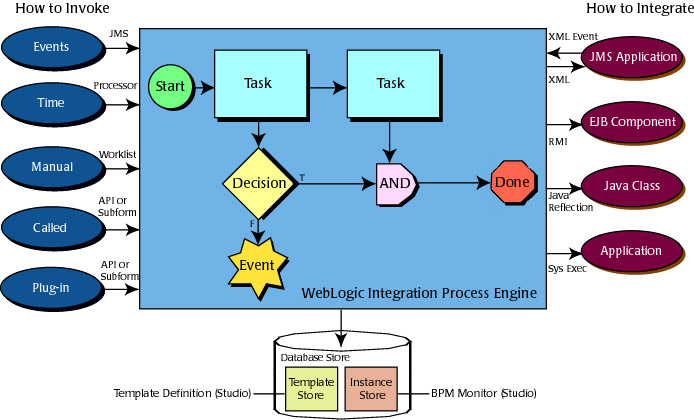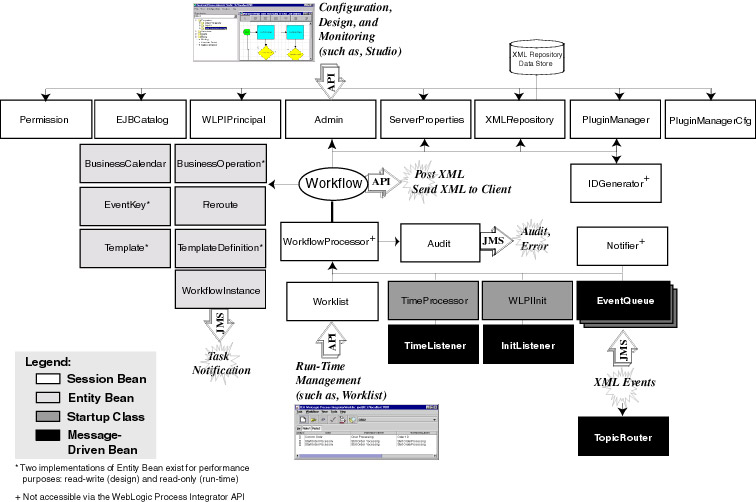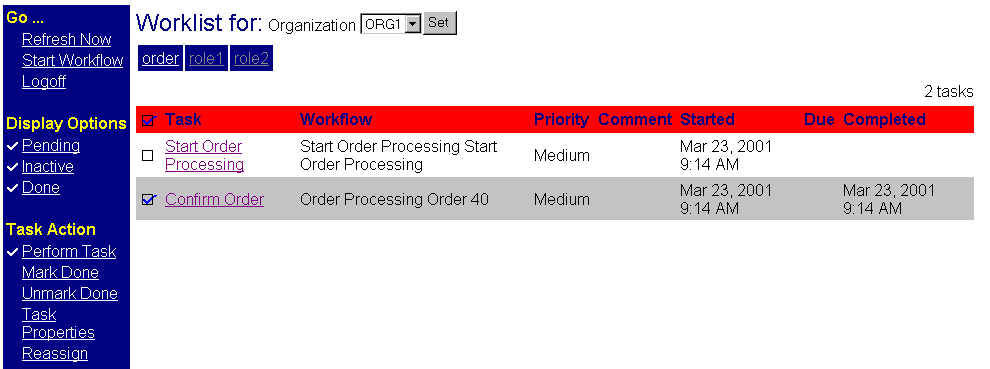


|

|
|
|
|
Business Process Management API Development
This section provides an overview of application development using the business process management (BPM) API. It includes the following topics:
Introduction
To support business process management (BPM), WebLogic Integration provides the following components:
These components make up the basic BPM framework for designing, executing, and monitoring business processes, and administering related data with WebLogic Integration.
In addition to using these design and run-time management clients, you can create custom clients to manage your business processes, and/or enhance the existing set of user interface features using the BPM application programming interface (API).
This document describes how to use the BPM API to create custom configuration, design, run-time management, and monitoring clients. For more information about the API, see the BEA WebLogic Integration Javadoc.
Note: For an overview of the business process model, and details about using the Studio client interface to administer, design, and monitor business processes, see Using the WebLogic Integration Studio.
For details about using the Worklist client interface to execute business processes, see Using the WebLogic Integration Worklist.
WebLogic Integration Process Engine
The following figure illustrates the BPM processing model.
Figure 1-1 BPM Processing Model
Note: For a complete description of the BPM processing model, see Using the WebLogic Integration Studio. Note that the BPM processing model depends on the WebLogic Integration process engine, which serves as the controller for run-time instances, managing their execution and monitoring their progress. In the previous figure, the left column lists the methods through which you can start (or instantiate) a business process or interact with an existing business process: in response to an XML event, as a time-based event, through a manual call, through a call from another business process, or through a plug-in interface. The right column lists the entities that can be integrated into a business process: JMS application, EJB component, Java class, or another application. The database store, shown at the bottom of the figure, stores templates, template definitions, and run-time instances. You can create templates and template definitions, and monitor run-time instances using the Studio or a custom design client. WebLogic Server Infrastructure The WebLogic Integration process engine runs on BEA WebLogic Server and takes advantage of the Java 2 Platform, Enterprise Edition (J2EE) services listed in the following table. For more information about WebLogic Server services, see Introduction to BEA WebLogic Server, in the BEA WebLogic Server document set, available at the following URL: http://download.oracle.com/docs/cd/E13222_01/wls/docs61/intro/index.html
Table 1-1 WebLogic Server Services Used by BPM
Process Engine Component Architecture The WebLogic Integration process engine consists of the following components:
The architecture of the process engine, including client and JMS interactions, is illustrated in the following figure.
Figure 1-2 Process Engine Component Architecture
Note the following in the previous figure:
The following sections describe the process engine components in more detail.
Session EJBs
Session EJBs provide application services to clients upon request. The BPM session EJBs provide the primary interface to the process engine.
The following table summarizes the functions of the BPM session EJBs, which are accessible to client applications via the BPM API (except where noted). It also indicates whether each EJB is stateful or stateless.
| 1
Not available to the BPM API. |
Stateful session EJBs are available to a client for the duration of a session, until the client releases the resource.
Stateless session EJBs, on the other hand, are a shared commodity. That is, a particular EJB can be accessed by multiple clients; there is no guarantee that the same EJB will be used by the process engine to handle multiple method calls to the EJB. Stateless session EJBs facilitate clustering, as subsequent method calls can be handled by different instances of an EJB on one or more servers.
For more information about the session EJBs available via the BPM API, see BPM API.
Entity EJBs
Entity EJBs represent data objects and include state information.
The BPM entity EJBs are not accessible directly through the BPM API; however, the com.bea.wlpi.common package provides classes for obtaining state information. For more information about the com.bea.wlpi.common package, see Client/Server Common Package.
The following table describes the BPM entity EJBs.
Startup Classes
The following table describes the BPM startup classes.
Message-Driven Beans
The following table describes the BPM message-driven beans.
Table 1-5 Message-Driven Beans
BPM API
The business process management (BPM) API consists of nine EJBs (summarized in the table Session EJBs) and the following seven packages:
The IDGenerator, Notifier, and WorkflowProcessor EJBs are not included in the BPM API.
The API components are described in detail in the following sections. For additional information, see the BEA WebLogic Integration Javadoc. For information about interfacing with the API session EJBs, see Connecting to the Process Engine.
Admin Session EJB
The com.bea.wlpi.server.admin.Admin session EJB is a stateful EJB that serves as the primary interface for design clients, including the Studio and custom design clients.
Using the public methods provided by the Admin EJB, you can:
Audit Session EJB
The com.bea.wlpi.server.audit.Audit session EJB is a stateless EJB that encapsulates a WebLogic JMS topic (wlpiAudit) to which the process engine sends audit and error messages on behalf of clients. The Audit EJB also encapsulates access to the wlpiError topic, to which error messages are sent. Users define audit entries via task actions when designing workflow template definitions, as described in Using the WebLogic Integration Studio.
Each audit message consists of an XML document that conforms to the format defined in the Audit DTD. For more information about the Audit DTD format, see Audit DTD or the BEA WebLogic Integration Javadoc.
Audit information (Info) and error (Error) messages are sent to the WebLogic Server log file, using the subsystem name WLPI.
For more information about setting up a JMS connection to the wlipAudit and wlpiError JMS topics, see Establishing JMS Connections.
EJBCatalog Session EJB
The com.bea.wlpi.server.catalog.EJBCatalog session EJB is a stateful EJB that classifies the EJBs deployed on a particular server. The EJBCatalog session EJB scans the JNDI tree, collects the EJB metadata, and stores it in a catalog. The EJBCatalog is used by design clients to define business operations.
Using the public methods provided by the EJBCatalog EJB, you can:
Permission Session EJB
The com.bea.wlpi.server.permission.Permission session EJB is a stateless EJB that enables you to get and set security permissions pertaining to both role and user actions.
PluginManager Session EJB
The com.bea.wlpi.server.plugin.PluginManager session EJB is a stateless EJB that provides run-time management of plug-ins during workflow execution.
For more information about programming plug-ins and the PluginManager EJB, see Programming BPM Plug-Ins for WebLogic Integration.
PluginManagerCfg Session EJB
The com.bea.wlpi.server.plugin.PluginManagerCfg session EJB is a stateless EJB that enables you to manage the implementation of user-defined plug-ins.
For more information about programming plug-ins and the PluginManagerCfg EJB, see Programming BPM Plug-Ins for WebLogic Integration.
ServerProperties Session EJB
The com.bea.wlpi.server.serverproperties.ServerProperties session EJB is a stateless EJB that enables clients to obtain information about the properties governing BPM.
Using the public methods provided by the ServerProperties EJB, you can get the following information:
WLPIPrincipal Session EJB
The com.bea.wlpi.server.principal.WLPIPrincipal session EJB is a stateless EJB that enables clients to interface with the WebLogic Server security realm and access BPM organizations, roles, users, and other security properties. BPM roles map to WebLogic Server security groups; BPM users, to WebLogic Server users.
Using the public methods provided by the WLPIPrincipal EJB, you can configure, manage, and obtain information about the organizations, roles, and users that ensure secure access to the system.
Note: Information about roles and users beyond the WebLogic Server-specific information that is stored in the WebLogic Server security realm, is maintained in the BPM database.
Worklist Session EJB
The com.bea.wlpi.server.worklist.Worklist session EJB is a stateful EJB serving as the primary interface for run-time management clients, including Worklist and custom run-time management clients. The Worklist EJB enables interaction with running instances.
Using the public methods provided by the Worklist EJB, you can:
XMLRepository Session EJB
The com.bea.eci.repository.ejb.XMLRepository session EJB is a stateless EJB that provides access to the XML repository database.
Using the public methods provided by the XMLRepository EJB, you can:
Client Common Package
The com.bea.wlpi.client.common package provides common client-side classes used by a BPM client. This package includes classes for:
Client Utility Package
The com.bea.wlpi.client.util package provides two JMS utilities, JMSTest and JMSTestAddr, for testing the publish and subscribe features of a JMS topic.
Client/Server Common Package
The com.bea.wlpi.common package provides classes used by both the BPM client and the WebLogic Integration process engine. The package includes:
Package members can be serialized to facilitate the exchange of information between the client and the server.
Plug-In Common Package
The com.bea.wlpi.common.plugin package provides common classes used to manage user-defined plug-ins.
For more information, see Programming BPM Plug-Ins for WebLogic Integration.
Security Common Package
The com.bea.wlpi.common.security package provides common classes used to define security permissions. The package includes:
Utility Package
The com.bea.wlpi.util package provides general BPM utilities, including a utility for generating message-driven beans.
XML Repository Helper Package
The com.bea.eci.repository.helper package provides common classes used to access the XML repository. The package includes:
BPM Application Development Tasks
The BPM API enables users to accomplish the application development tasks described in the following sections.
Configuration
The BPM API, via the Studio client or a custom configuration client, enables users to configure:
Part II of this document, Configuration, describes how to configure each of these types of entities using the BPM API. For more information about the API, see the BEA WebLogic Integration Javadoc.
Design
The BPM API, via the Studio client or a custom design client, enables users to perform the following types of design tasks:
Part III of this document, Design, describes how to perform each of these types of design-related tasks using the BPM API. For more information about the API, see the BEA WebLogic Integration Javadoc.
Run-Time Management
The BPM API, via the Worklist or a custom run-time management client, enables users to perform the following types of run-time management tasks:
Part IV of this document, Run-Time Management, describes how to perform each of these types of run-time management tasks using the BPM API. For more information about the API, see the BEA WebLogic Integration Javadoc.
Monitoring
The BPM API, via the Studio or a custom monitoring client, enables users to perform the following types of monitoring tasks:
Part V of this document, Monitoring, describes how to perform each of these types of monitoring tasks using the BPM API. For more information about the API, see the BEA WebLogic Integration Javadoc
Plug-In Development
The BPM API enables users to design and integrate custom plug-ins.
For more information, see Programming BPM Plug-Ins for WebLogic Integration.
BPM API Examples
The examples used throughout this document are excerpted from the BPM client examples provided with the software in the samples/bpm_api directory. The client examples include:
The client examples are described in detail in the following sections.
Command-Line Administration Example
WebLogic Integration provides an example that demonstrates the basic administration tasks that you might support in a custom command-line client. These tasks include:
The command-line administration example consists of one Java file, CLAdmin.java, located in the samples/bpm_api/commandline directory. For information about how to compile and run this example, see the Readme.txt file in this directory.
Some of the examples presented in Part I, API Development Fundamentals, and Part II, Configuration, are excerpted from the command-line administration example.
Command-Line Studio Example
WebLogic Integration provides an example that demonstrates basic design tasks that you might support in a custom command-line studio client, including:
The command-line studio example consists of one Java file, CLStudio.java, located in the samples/bpm_api/commandline directory. For information about how to compile and run this example, see the Readme.txt file in this directory.
Some of the examples presented in Part III, Design, are excerpted from the command-line studio example.
Command-Line Worklist Example
WebLogic Integration provides an example that demonstrates the basic worklist management tasks that you might support in a custom command-line worklist client. These tasks include:
The command-line worklist example consists of one Java file, CLWorklist.java, located in the samples/bpm_api/commandline directory. For information about how to compile and run this example, see the Readme.txt file in this directory.
Some of the examples presented in Part IV, Run-Time Management, are excerpted from the command-line worklist example.
Command-Line SAX Parser Example
WebLogic Integration provides an example that demonstrates how to use a SAX parser to parse client requests received from the BPM server. Specifically, this example illustrates how to:
The command-line SAX parser example consists of one Java file, CLSaxParser.java, located in the samples/bpm_api/commandline directory. For information about how to compile and run this example, see the Readme.txt file in this directory.
Some of the examples presented in Part IV, Run-Time Management, are excerpted from the command-line worklist example.
JSP Worklist Example
WebLogic Integration provides an example that demonstrates the basic run-time management tasks that you might support in a custom Java Server Page (JSP)-based worklist client. The main component of this example is the worklist.jsp file, which provides the main interfaces to the JSP worklist.
The following table lists the tasks that are demonstrated by the JSP client, and identifies example files to view for more information.
Table 1-6 JSP Worklist Example
The following figure shows the main JSP interface, worklist.jsp.
Figure 1-3 Main Interface to the JSP Worklist
For information about this example, see the Readme.txt file in the following BPM directory: samples/bpm_api/jsp. Some of the examples presented in Part IV, Run-Time Management, are excerpted from the JSP worklist example. 

|

|

|
|
|
|
Copyright © 2001 BEA Systems, Inc. All rights reserved.
|